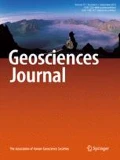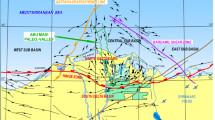Abstract
Fluvial-deltaic channel sands act as an excellent host for hydrocarbons in various parts of the globe. However, the prediction of channel sand reservoirs is a challenging job for geoscientists. The aim of the present study is to provide a workflow that can be used to delineate fluvial-deltaic sand reservoirs by applying the continuous wavelet transform (CWT) technique of spectral decomposition (SD) on 3D poststack seismic data from the Miano gas field in the Southern Indus Basin, Pakistan. Full spectrum attributes such as amplitude, root-mean-square (RMS) amplitude, coherence and sweetness help to map the fluvial-deltaic sands down to a certain depth, but not at the reservoir level. Nevertheless, the CWT and some conventional seismic attributes, along with the 3D visualization, can be helpful in demarcating the potential sands, thereby predicting the lithology, gas pay zones and the thicknesses of the productive zones. This workflow may serve to mark out the stratigraphic hydrocarbon reservoir compartments within fluvial-deltaic systems in the Southern Indus Basin, Pakistan.
Similar content being viewed by others
References
Ahmed, W., Azeem, A., Abid, M.F., Rasheed, A., and Aziz, K., 2013, Mesozoic structural architecture of the Middle Indus Basin, Pakivstan–controls and implications. Pakistan Association of Petroleum Geoscientist/Society of Petroleum Engineers Annual Technical Conference, Islamabad, Pakistan, p. 1–13.
Ahmad, M.N. and Rowell, P., 2012, Application of spectral decomposition and seismic attributes to understand the structure and distribution of sand reservoirs within Tertiary rift basins of the Gulf of Thailand. The Leading Edge, 31, 630–634.
Ahmed, N., Fink, P., Sturrock, S., Mahmood, T., and Ibrahim, M., 2004, Sequence stratigraphy as a predictive tool in Lower Guru Fairway, Lower and Middle Indus Platform, Pakistan. Pakistan Association of Petroleum Geoscientists, Annual Technical Conference, Islamabad, Oct. 8–9.p 17–18.
Castagna, J.P., 2006, Comparison of spectral decomposition methods. First Break, 24, 75–79.
Galloway, W.E. and Hobday, D.K., 1995, Terrigenous clastic depositional systems: Applications to Fossil Fuel and Groundwater Resources. Springer, Berlin, 417 p.
Krois, P., Mahmood, T., and Milan, G., 1998, Miano field, Pakistan, a case history of model driven exploration. Proceedings of the Pakistan Petroleum Convention, Pakistan Association of Petroleum Geoscientists, Islamabad, Nov. 25–26, p 111–131.
Kadri, I.B., 1995, Petroleum geology of Pakistan. Graphic Publishers, Karachi, 108 p.
Naseer, M.T., Asim, S., Ahmed, M.N., Hussain, F., and Qureshi, S.N., 2014, Application of seismic attributes for delineation of channel geometries and analysis of various aspects in terms of lithological and structural perspectives of Lower Goru Formation, Pakistan. International Journal of Geosciences, 5, 1490–1502.
Partyka, G., Gridley, J., and Lopez, J., 1999, Interpretational applications of spectral decomposition in reservoir characterization. The Leading Edge, 18, 353–360.
Peyton, L., Bottjer, R., and Partyka, G., 1998, Interpretation of incised valleys using new 3-D seismic techniques: A case history using spectral decomposition and coherency. The Leading Edge, 17, 1294–1298.
Radovich, B.J. and Oliveros, R.B., 1998, 3-D sequence interpretation of seismic instantaneous attributes from the Gorgon field. The Leading Edge, 17, 1286–1293.
Shah, S.M.I., 1977, Stratigraphy of Pakistan. Geological Survey of Pakistan, Quetta, 12, 51 p.
Sinha, S., Routh, P.S., Anno, P.D., and Castagna, J.P., 2005, Spectral decomposition of seismic data with continuous-wavelet transform. Geophysics, 70, 19–25.
Zuo, G., Lu, F., Fan, G., and Shao, G., 2012, Study of hydrocarbon detection methods in offshore deepwater sediments, Gulf of Guinea. AAPG Annual Convention and Exhibition, Long Beach, April 22–25. http://www.searchanddiscovery.com/pdfz/documents/2012/40999zuo/ndx_zuo.pdf.html
Author information
Authors and Affiliations
Corresponding author
Rights and permissions
About this article
Cite this article
Tayyab, M.N., Asim, S. Application of spectral decomposition for the detection of fluvial sand reservoirs, Indus Basin, SW Pakistan. Geosci J 21, 595–605 (2017). https://doi.org/10.1007/s12303-017-0003-y
Received:
Accepted:
Published:
Issue Date:
DOI: https://doi.org/10.1007/s12303-017-0003-y




